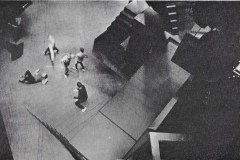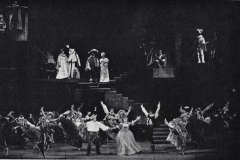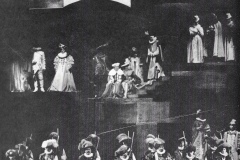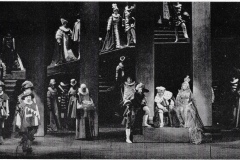Music by Laurie Johnson
Lyrics by Herbert Kretzmer
Book by Michael Pertwee
Directed by Peter Coe
Set Design and Lighting by Sean Kenny
Choreography by Donald McKayle
Costumes Designed by Loudon Sainthill
Fight Arrangements by William Hobbs
Company & Stage Manager: Peter H Roberts
Deputy Stage Manager: Stella Richards
Theatre Royal Drury Lane
Premiere: 5 December 1967
Closed: 18 January 1969
The show ran for 462 performances.
Reviews used in listings:
“Glittering Gigantic Breathless Knock-About Musical” Sketch
“A Triumph” Evening News
“A Great Thumping Success” The Sun
“Dazzling, Tuneful and with a touch of the Goon” Daily Express
From Harry Secombe’s autobiography ‘An Entertaining Life’:
“The massive sets presented many problems for the cast. They consisted of a complex central revolve which included four sets of stairs, each of which swivelled, integrated with great blocks, slabs and towering shapes, plus two side units that could move out on five horizontal tracks to link up to the central unit by means of flying drawbridges. In addition, there were other large units that were let down from the flies. These included arches, columns and heraldic emblems – one of which clobbered me one night. All this mechanical wizardry was worked electronically and moved while supporting members of the cast.
Documents
The Making of a Musical (from souvenir programme)
What is the link between six tons of steel girders and six rubber helmets… 3,456 yards of ribbon and 4lbs. of dry ice… Harry Secombe and a pedigree White Persian kitten?
“The Four Musketeers” supplies the answer, for many and varied are the ingredients that have gone into the making of this mammoth musical.
The six tons of steel girders were laid under the stage to support the massive set. The rubber helmets protect the heads of the acrobatic musketeers during their spectacular fights and falls. The ribbon, cut into 6 inch strips, forms the trimming on the dancers’ skirts in the can-can-type number “Churches La Femme” (18 rolls of 24 yards for each dancer). The dry ice, combined with cosmetic oil smoke, produces the steam in the thermal bath sequence (4lbs. of it is used at each performance). Harry Secombe needs no explanation, and the White Persian kitten … well, it seems that Cardinal Richelieu likes to have one around.
The idea of a comedy musical loosely based on Dumas’ “The Three Musketeers” came to composer Laurie Johnson and lyric writer Herbert Kretzmer almost simultaneously. Enthusiasm snowballed from there through writer Michael Pertwee, director Peter Coe and designer Sean Kenny to impresario Bernard Delft, who arranged to present the show at the Theatre Royal, Drury Lane, thus making it the first British musical to be presented there since Noel Coward’s ‘Pacific 1860″: in 1946.
Harry Secombe was delighted at the prospect of creating the role of the fourth musketeer, D’Artagnan, and immediately began growing a beard. Other actors of calibre were signed for leading roles and in due course an impressive cast list was headed by Elizabeth Larner, Kenneth Connor, Stephanie Voss, Aubrey Woods and Sheena Marshe.
Loudon Sainthill set up base at Berman’s with his costume designs, assisted by wardrobe supervisor Janet Roberts. Donald McKayle flew in from America to do the choreography; the services of William Hobbs were enlisted for the fight arrangements, and Derek New was appointed Musical Director.
Rehearsals began in theatres, dance studios and church halls, and swords became a familiar sight in West End streets – though not familiar enough to one policeman, who tried to arrest 12 dancers on their way to rehearsal on the charge of carrying unsheathed weapons! (All was well when he felt the blunt points.).
The combination of fencing and dancing in the show is an innovation in the British musical field and Bill Hobbs, whose work as Fight Director for the National Theatre is normally confined to drama, made the most of the chance of working with highly-trained dancers. His long-standing interest in fights to rhythms and symbolic fights (an example is the clash between the musketeer acrobats before the arrival of the Cardinal’s Guard, which is influenced by the Chinese classical theatre) was given full scope. Ballet mistress Nita Howard was given the rank of Dance Captain.
Meanwhile, back at “the Lane”…
Sean Kenny was at work directing operations in the vast stage area – an 80-foot cube – used in full depth for the first time since before the war, and a hundred men worked day and night under the supervision of production manager Maurice Fournier.
Two false floors put in for “Camelot” and “Hello Dolly” were removed and five lifts under the stage were lowered so that the frame of steel girders could be laid into the well and topped with timber. The sixth lift remained in action for raising and lowering the bath and massage slabs in the thermal baths sequence.
The pivot of the sets is a 2 h.p. motor located in the centre of the stage, and 15 subsidiary machines provide limitless variations of movement.
The immense and complex operation of set movement is controlled entirely from one switch panel, operated by company manager Peter Roberts, and as many as 25 consecutive moves on the board are required as the massive drawbridges, staircases, ramps and pillars go into action. The towers that ride on the top of the stage comprise eight tons of steel frames clad with wood. Even the bubbles and steam in the thermal baths, the explosions and the fireworks are controlled from the switch panel.
So vast are the resources at Drury Lane that it is the only theatre in London to employ a Chief Engineer and to boast a store of mechanical tricks and machinery reminiscent of a ship’s engine room. Sean Kenny has used the whole repertoire.
Loudon Sainthill’s costumes are as loosely based on the period as the musical is on the original classic.
The skirts for the “Churches La Femme” number would have looked wrong with frills, for the can-can was not yet being danced in Paris, so the ribbon strips were devised instead.
The size of the Drury Lane stage had to be considered and the costumes given extra volume.
Even the musketeers’ hats were specially created, and they follow through Loudon Sainthill’s belief that feathers should not look as though they have been stuck on a hat but are growing from it.
Fred Brazier of Germans worked late into the evening for eight weeks to complete work on the 200 costumes in the show, which range from the Cardinal’s guards’ uniforms – made of upholstery vinyl to stand up to all the fighting – to the velvet, be-jewelled robes and gowns at the royal palace, where an eye-catching sight is Queen Anne’s gold lace and appliqué catsuit. Made by leading theatre couturier Harry Sneider, it is embroidered with amethysts and worn under a coat dress of lame and organza. Her crown is made by the expert in costume jewellery and head-dresses, Hugh Skillen.
The hundreds of musketeers’ shirts involved and laundered every day and ironed by hand – one of the many major tasks supervised by the wardrobe mistress.
A mighty production, and when director Peter Coe had welded all the elements together and the curtain rose on opening night, December 5, 1967, it was time to celebrate indeed. After 21 years, British talent had returned to Drury Lane.
Production credits from programme
Scenery built by Brunskill & Loveday Ltd.
Engineering by Hall Stage Equipment Ltd.
Special Effects by I.E.S. Projects Ltd.
Lighting Equipment by Strand Electric and Engineering Co.
Sound Equipment by Stagesound Ltd.
Properties by Elizabeth Hetherington Ltd.
Masks by Theatre Studios Ltd.
Scenery Painted by Tod Kingsman Ltd.
Projections designed by Malcolm Lewis and executed by Strand Electric.
Additional Properties by Derek Howarth.
Fireworks by Joseph Wells & Sons Ltd. Dartford
Special flying effects by Eugene’s Flying Ballet.





